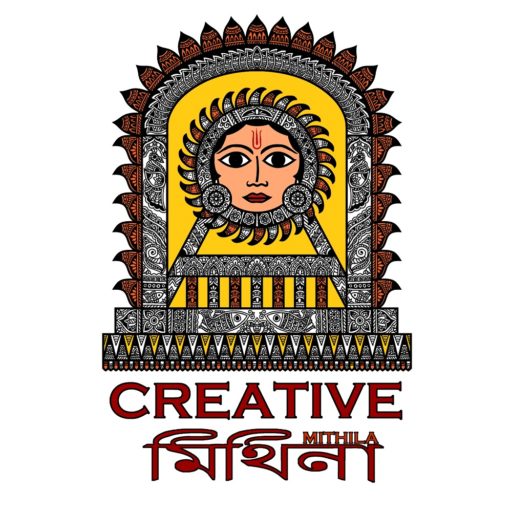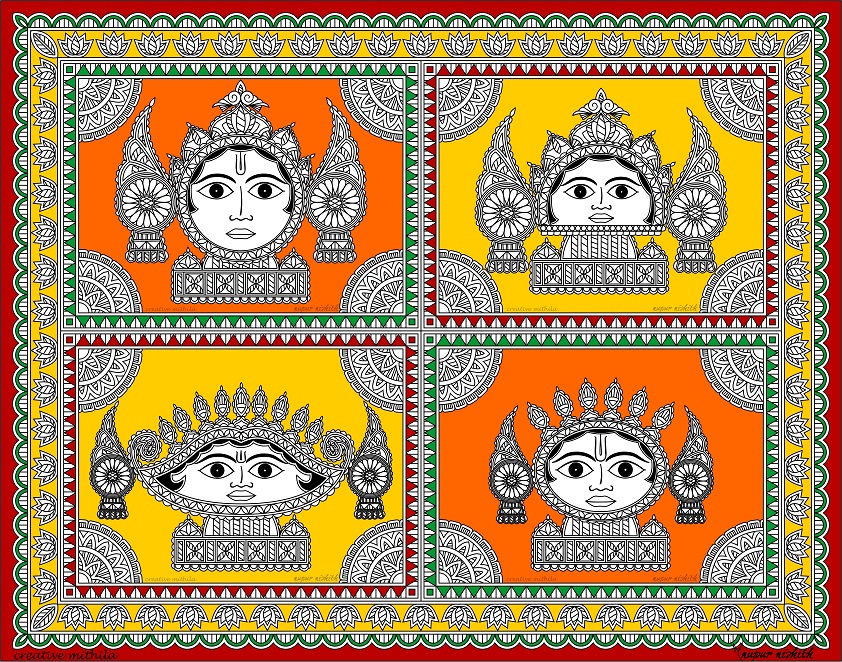
Surya, Chandrama, Navagrah , Shashti (Sun, Moon, Nine planets and Shashti (Goddess of Nature) in Mithila / Madhubani Paintings.
In this painting, major elements from Solar System, Sun, Moon and Nine Planets along with Shashtika , Goddess of Shristi (Nature / Creation) have been digitally painted in the motifs of Mithila / Madhubani Painting. These are symbolic representations
Traditionally in Mithila Paintings, many themes and motifs have been inspired from Nature. Sun, Moon, Universe, Animals, Birds, Plants, various objects etc were painted often in various forms in both Aripans (Floor paintings) and Bhitti Chittra (Wall paintings) as mode of symbolic participation of all as blessings in the occasion.
Surya (Sun) , Chandrama (Moon), Navagraha (Nine Planets) and Shashthi (Goddess of Shristi ( Nature / Creation)) are commonly made in most of the Aripan (Floor Painting ) and some of Wall Paintings especially during the various rituals during and after weddings, eg. in Kohbar on wall during wedding , the aripan made during the rituals of Vat Savitri, Madhushravani, and many others. It is considered as blessings from Sun, Moon, Nine Planets and Goddess Shashtika, who is symbolically considered as Goddess of Shristi (Nature / Creation). These along with Gaur (not present in this painting) are also considered as symbol of the “Panch Tatva” ( 5 elements which construct the Human body as per Hindu Mythology ).
In Mithila painting, objects are also considered even symbolically in human form. So in these paintings , they have mostly a face with eyes, nose, mouth, ears etc. Since Sun is symbolically round so the face of the Sun has been kept round circle while the face of Moon is commonly made as semi circle as the shape keeps changing. In Navagrah, there are Nine pointers on the head for the Nine planets. Traditionally Goddess Shashtika has been made with Six pointers on the head. It may be because “Shashthi” means “Six” in Sanskrit.
In this painting, there is a slight drift from the traditional style in terms of colouring. However, in Aripans (Floor painting) and traditional Bhitti Chitra (Wall Paintings) they were mostly single colour either, White or Yellow Pithar on floor or Red, Yellow or colours on wall. Additionally in order to decorate the wall paintings, they were filled with colours too. The essence has been kept intact with the main designs in black and white though coloured the background in other colours. This was done to slightly add a contemporary twist to the traditional motifs in the painting .
Mode : Digital Painting
Artist : Nupur Nishith


Gopal Sinha
November 8, 2014 - 3:31 am ·मिथिला चित्र-कला के प्रति दो पीढ़ियों का समर्पण सराहनीय है। रेखांकन सजीव हैं। रंगों का संयोजन अच्छा है, तथापि चंद्रमा की पृष्ठभूमि नीले/आसमानी रंग में संभवत:अधिक बोधगम्य होती। नवग्रह और षष्ठी देवी के केश-विन्यास अदले-बदले जा सकते थे। एक कला-विहीन दर्शक की अनावश्यक प्रतिक्रिया से अधिक इन विचारों का मूल्य नहीं है।
nupur nishith
November 8, 2014 - 4:58 am ·धन्यवाद।
कला के प्रति सभी का अपना दृष्टिकोण हो सकता है। आपके सुझाव रोचक एवं गौर करने योग्य है। इनसे मुझे अनेक नए विचार आते हैं। अगली बार इन्हें प्रयोग में लाने का ज़रूर प्रयास करूंगी।